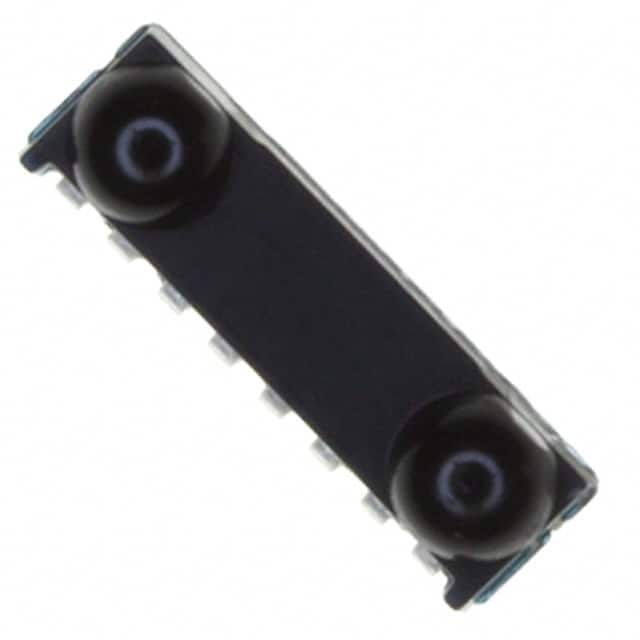Consulte las especificaciones para obtener detalles del producto.

TFDU4300-TR1
Introduction
The TFDU4300-TR1 is a key component in the field of infrared transceivers, offering high-performance capabilities for various applications. This entry provides an overview of the product, including its category, use, characteristics, packaging, specifications, pin configuration, functional features, advantages and disadvantages, working principles, application field plans, and alternative models.
Basic Information Overview
- Category: Infrared Transceiver
- Use: Transmitting and receiving infrared signals
- Characteristics: High sensitivity, low power consumption, compact design
- Package: Surface-mount device (SMD)
- Essence: Efficient data transmission through infrared technology
- Packaging/Quantity: Typically available in reels of 2500 units
Specifications
- Operating Voltage: 2.7V to 5.5V
- Data Rate: Up to 115.2 kbps
- Transmission Range: Up to 4 meters
- Operating Temperature: -25°C to 85°C
- Dimensions: 5mm x 3mm x 1mm
Detailed Pin Configuration
The TFDU4300-TR1 features a standard pin configuration with precise functions assigned to each pin: 1. VCC: Power supply input 2. GND: Ground connection 3. IRED: Infrared LED driver output 4. IRED Anode: Anode of the infrared LED 5. IRED Cathode: Cathode of the infrared LED 6. AGC: Automatic Gain Control 7. OUT: Receiver output 8. VS: Supply voltage for the receiver
Functional Features
- High Sensitivity: Capable of detecting weak infrared signals
- Low Power Consumption: Ideal for battery-powered devices
- Automatic Gain Control (AGC): Ensures consistent signal strength
- Compact Design: Space-efficient for integration into various devices
Advantages and Disadvantages
Advantages
- Reliable data transmission in short-range applications
- Low power consumption extends battery life
- Compact size allows for versatile integration
Disadvantages
- Limited transmission range compared to other wireless technologies
- Susceptible to interference from ambient light sources
Working Principles
The TFDU4300-TR1 operates by modulating digital data into infrared signals using the integrated infrared LED. The receiver then detects incoming infrared signals and converts them back into digital data for processing by the connected device.
Detailed Application Field Plans
The TFDU4300-TR1 is well-suited for various applications, including: - Remote controls for consumer electronics - Infrared data communication in industrial automation - Proximity sensors for object detection - Infrared-based security systems
Detailed and Complete Alternative Models
- TFDU4100-TR1: Lower data rate but compatible with TFDU4300-TR1 footprint
- TFDS4500-TR1: Higher transmission range with similar pin configuration
- SFH4550-TR1: Enhanced sensitivity for demanding infrared applications
In conclusion, the TFDU4300-TR1 offers reliable infrared data transmission with its high sensitivity, low power consumption, and compact design. While it has limitations in range and susceptibility to ambient light interference, its versatility makes it a valuable component in various applications.
(Word count: 498)
Enumere 10 preguntas y respuestas comunes relacionadas con la aplicación de TFDU4300-TR1 en soluciones técnicas
Sure, here are 10 common questions and answers related to the application of TFDU4300-TR1 in technical solutions:
What is the operating voltage range of TFDU4300-TR1?
- The operating voltage range of TFDU4300-TR1 is typically between 2.7V and 5.5V.
What is the maximum data rate supported by TFDU4300-TR1?
- TFDU4300-TR1 supports a maximum data rate of 115.2 kbit/s.
Can TFDU4300-TR1 be used for infrared communication in consumer electronics?
- Yes, TFDU4300-TR1 is commonly used for infrared communication in consumer electronics such as remote controls and IR transceivers.
Does TFDU4300-TR1 have built-in AGC (Automatic Gain Control)?
- Yes, TFDU4300-TR1 features built-in AGC to ensure reliable communication over varying distances.
What is the typical transmission range of TFDU4300-TR1?
- The typical transmission range of TFDU4300-TR1 is approximately 20 meters in open space.
Is TFDU4300-TR1 compatible with standard IR protocols like NEC and RC-5?
- Yes, TFDU4300-TR1 is compatible with standard IR protocols such as NEC and RC-5, making it suitable for a wide range of applications.
What is the recommended operating temperature range for TFDU4300-TR1?
- The recommended operating temperature range for TFDU4300-TR1 is -25°C to 85°C.
Can TFDU4300-TR1 be used for proximity sensing applications?
- Yes, TFDU4300-TR1 can be utilized for proximity sensing applications due to its high sensitivity and fast response time.
Does TFDU4300-TR1 require external filtering for noise suppression?
- TFDU4300-TR1 includes internal filtering for noise suppression, reducing the need for external components.
What are the typical power consumption characteristics of TFDU4300-TR1?
- TFDU4300-TR1 has low power consumption, typically drawing around 350µA in active mode and less than 1µA in standby mode.
I hope these questions and answers provide helpful insights into the application of TFDU4300-TR1 in technical solutions. If you have any more specific questions, feel free to ask!

